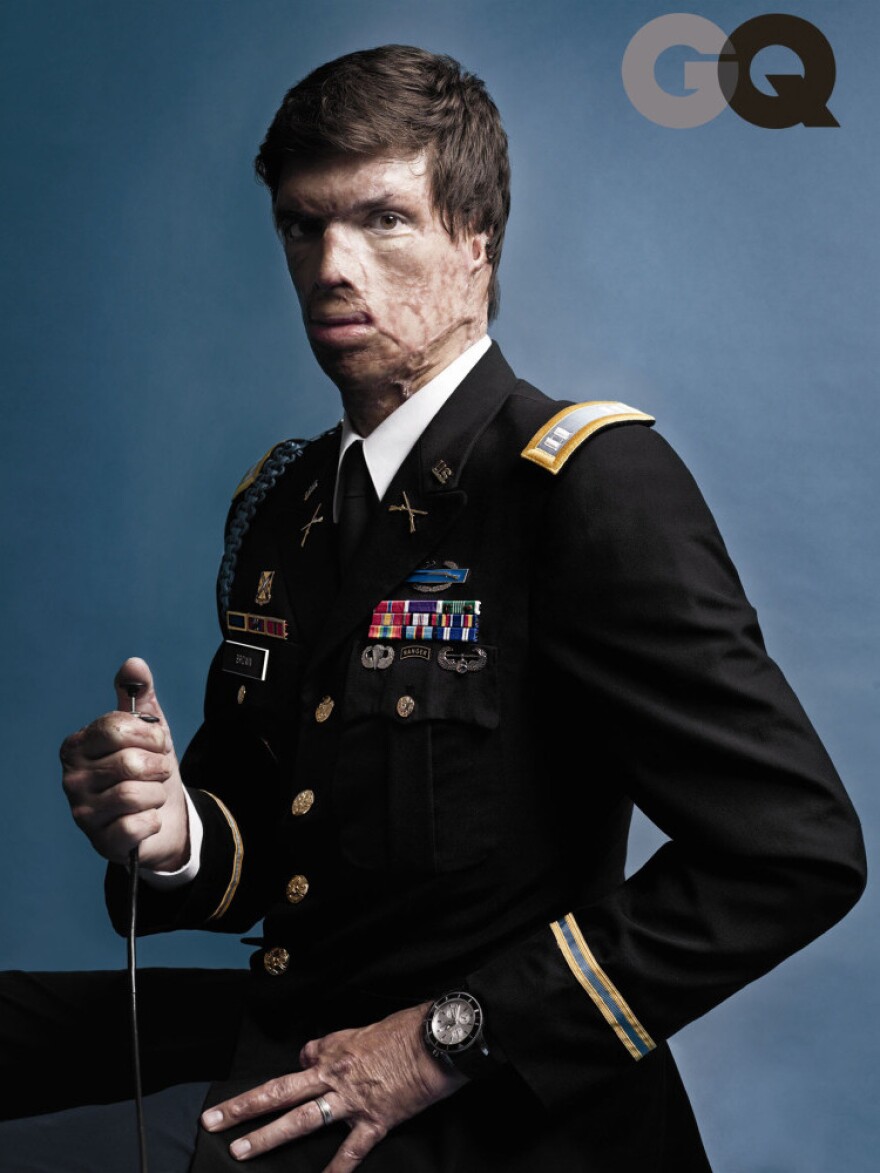For troops injured in Iraq and Afghanistan, the deepest physical pain often comes much later — weeks, or even months, after the incident. That was the case for Sam Brown, whose story appears in this month's GQ magazine.
Brown graduated from West Point in 2006. In the late summer of 2008, he was deployed to southern Afghanistan to lead a platoon. He did security for base construction and made sure the local villagers had enough food, water, and medicine.
It was hot, often mind-numbingly dull, and dusty.
"We called it moon dust," Brown tells weekends on All Things Consideredhost Guy Raz. "It was just this kind of powdery dust that stuck to everything. No access to showers for a couple of weeks, you know, at a time, and there were days when it peaked out at close to 130 degrees."
Before he deployed, Brown ran through a series of scenarios in his mind, scenes of what might happen to him in Afghanistan.
"Interestingly enough, the one drill I didn't run on myself was burning," he says. "That just, for whatever reason, did not cross my mind as a potential type of casualty."
Then came the day in September 2008 that his unit was called in to back up another platoon that came under attack.
"I remember everything about the day I was injured," Brown says. "We hit an IED, right as we got to their location, and that was the beginning of a new life for me."
"He's not knocked unconscious immediately," says journalist Jay Kirk, who covered the story for GQ, and reconstructed what happened to Brown that day.
"He's on fire; he's down his knees with his arms just flaming. His face is on fire, and he's trying to put himself out, you know. He's rolling around as much as he can, you know, drop and roll, but he has a tactical vest on so that's preventing him from putting himself out."
Five days later, Brown was in the intensive care unit at the Brooke Army Medical Center in San Antonio. Almost immediately, to prevent infection, he was taken to a shower room where his skin was scrubbed by nurses.
"It was as close to the same pain of being burned as I expect you could get," Brown says.
He was put on Dilaudid, Percocet and morphine, but nothing helped with the most severe spikes of pain.
While burn treatments have advanced greatly in the past decade, Kirk says pain management is still in the 19th century.
"I mean this is a drug that was invented in 1804, but there haven't really been a lot of advances in it since then," he says of morphine. "And there is a lot of negative side-effects to opioids. You know, the more pain you're in, the more you need, the more you take, the greater the tolerance is, the less it works, and it's very dangerous."
Two thousand miles away from Brown's hospital bed, two researchers at the University of Washington's Medical Center in Seattle were working with burn patients who, like Brown, weren't responding to pain medication. One of those researchers is David Patterson.

"It takes a certain amount of attention to process pain," Patterson says. "If you are able to put that attention elsewhere, there is less attention to process pain, and consequently, people will feel less pain."
Patterson and his colleague Hunter Hoffman began to experiment with virtual reality to provide that distraction.
Hoffman had designed an environment called Spider World, aimed at treating arachnophobes. By wearing special goggles, you become immersed in a world of friendly spiders and gradually lose your fear.
Paterson and Hoffman thought a similar approach could work with burn patients.
"So we created a world that was the antithesis of fire," Hoffman says. "The opposite of fire, a cool place snowmen, pleasant images, just about everything to keep them from thinking about fire."
They called it SnowWorld.
When the Army found out about SnowWorld, it decided to try it out with troops burned in battle, including Brown.
"I was quite skeptical," Brown says, "but I was also at a place where I was willing to try anything that might help."
On a scale from 1 to 10, Brown's pain level often spiked at 8 during wound cleaning and physical therapy. So he placed the goggles on and entered SnowWorld.
"It was like being, watching a B-rated Pixar film," he says. "Everything about it was just cold and cool and cartoony."
But as Brown floated along the icy canyons, pelting snowmen and woolly mammoths with snowballs, something amazing happened: He forgot about his pain.
Brown spent more than a year undergoing surgery, and in physical therapy. His face was reconstructed using harvested skin from his back. And he also reconstructed his life: He fell in love with his dietitian, Amy Larsen, also an Army officer. She is now his wife, and last September, almost three years to the day after the IED changed his life, they had a baby boy. They named him Roman.
"I still in my own mind pictured myself for a long time as I was prior to the burn," Brown says. "But I'm at a place now where I picture myself as is, and the scars are really just a great reminder of who I am, and the opportunity I've been given in life. It's sort of an external tribute, or reminder to a new life."
Copyright 2020 NPR. To see more, visit https://www.npr.org.



